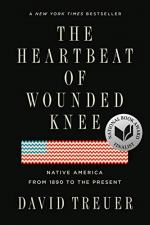|
This section contains 614 words (approx. 2 pages at 400 words per page) |

|
The Heartbeat of Wounded Knee Summary & Study Guide Description
The Heartbeat of Wounded Knee Summary & Study Guide includes comprehensive information and analysis to help you understand the book. This study guide contains the following sections:
This detailed literature summary also contains Topics for Discussion on The Heartbeat of Wounded Knee by David Treuer .
The following version of this book was used to create this guide: Treuer, David. The Heartbeat of Wounded Knee: Native America from 1890 to the Present. Riverhead Books, 2019.
Treuer’s book is divided into seven parts, each covering a historical period. Part 1 describes Native life in each region of the United States starting with early archeological evidence and continuing to the interactions with European and American colonists. It ends with the Wounded Knee massacre in 1890, which is the jumping off point for Treuer’s narrative. His intention is to provide a sequel and counter-argument to Dee Brown’s 1970 book, Bury My Heart at Wounded Knee. Brown’s book left the impression for many readers that Indian culture had come to a tragic halt with the horror of the Wounded Knee massacre. Treuer wants to demonstrate that since time immemorial, including in the traumatic period since the European invasion, Indians have adapted creatively to changing and adverse circumstances and are today a vibrant part of American life.
Part 2 covers government policy from the massacre at Wounded Knee to the New Deal of the 1930s. Beginning with this part, Treuer presents stories of modern Indians that reveal the variety and resilience of Indian life. American history, as he frames it, has led not to a demise of Indian cultural expressiveness but to meaningful continuity and adaptation. Among the events of this part are the 1824 creation of the Office (later Bureau) of Indian Affairs; the 1871 declaration by Congress that the tribes were no longer sovereign nations but wards of the state; policies of child separation, allotment, and assimilation, their basis in race, and the rise of reform movements led by non-Natives that served more to continue disastrous policies than to end them.
In Part 3, Treuer discusses Native American service in the two World Wars and how it affected Indians’ views of America and their place in the national consciousness. He covers the Indian New Deal of the 1930s and 40s, which brought needed economic resources and opportunity to the reservations.
In Part 4, Treuer takes the reader through the conservative reaction against the New Deal in the 1950s. The policy initiatives of the era, in part religiously motivated, resulted in the termination of federal wardship status and transfer of oversight responsibility to the states. Treuer follows Indian migration to the cities as the government pursues a policy of relocation.
Part 5 has to do with the rise of Indian civil rights in the 1960s and 70s and the development of a new Indian self-esteem. Treuer tells of the takeover of Alcatraz Island and the Washington, D.C. office of the Bureau of Indian Affairs, which contributed to the dismantling of the termination policy. He relates the stories of AIM leaders Dennis Banks, Russel Means, and Leonard Peltier, and their effects, both positive and otherwise, on the struggle for human rights.
Part 6 delves into the casino boom. Treuer tells of the plaintiffs behind the 1976 U.S. Supreme Court case Bryan v. Itasca Country that inaugurated a new era of self-determination. The Court’s decision affirmed that tribes retained sovereignty over their own commerce, clearing the way for them to undertake business ventures, and provide employment opportunity, health care, and infrastructure.
Part 7 brings the reader into the present day with discussions of digital businesses and the human rights effects of the 2016 Water Protector protest against the Dakota Access Pipeline at Standing Rock reservation. He considers the balance Indians strike between maintaining their heritage and accommodating changing circumstances.
Throughout, Treuer pursues the thesis that against tremendous adversity, Native peoples have successfully remade their world, and the world around them, again and again through what he calls “the radical act of living” (453).
Read more from the Study Guide
|
This section contains 614 words (approx. 2 pages at 400 words per page) |

|



